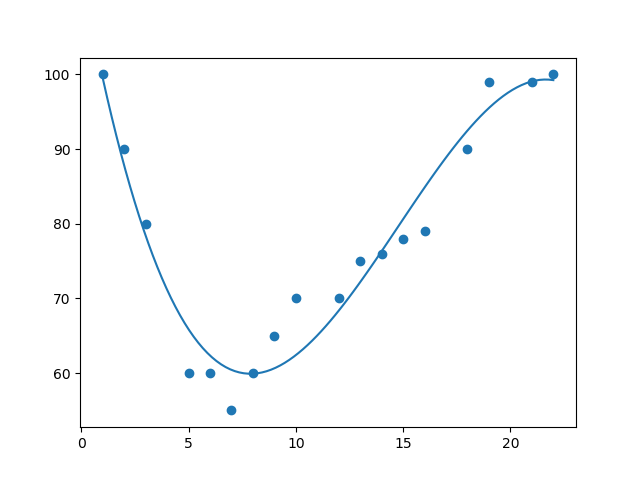04. Pandas
- 04.01 Overview
- Pandas is a Python library.
- Pandas is a way to analyze data, like excel sheets and VBA, database ides.
- It requires less programming knowledege.
- The name "Pandas" has a reference to both "Panel Data", like the tables in databases.
- Many times, we get data from databases, instead of csv files, or json files.
- We usually get data from database. W3C separates the topic between Pandas and machine learning.
- Pandas data also work for machine learning, like predictions.
# The following demo to demonstrate the structure of dataframe.
import pandas as pd
mydataset = {
'cars': ["Honda", "Toyota", "Ford"],
'ages': [6, 14, 3],
'color': ["blue", "grey", "black"]
}
myvar = pd.DataFrame(mydataset)
print(myvar)
cars ages colors
0 Honda 6 blue
1 Toyota 14 grey
2 Ford 3 black
- The process is to create a dataframe fom a python dictionary .
- All the values are type list.
- In the dataframe, cars, ages, colors are column names.
- In the dataframe, the left side, 0, 1,2 are index for rows
- Using method print for dataframe gives the whole table.
04.02 Named Indexes, Merge dataframes
- With the index argument, you can name your own indexes
- The following code, it is the same as default.
- To merge dataframes, use pandas's concat method.
import pandas as pd
data1 = {
"calories": [420, 380, 390],
"duration": [50, 40, 45]
}
df1 = pd.DataFrame(data1, index = [0, 1, 2])
data2 = {
"calories": [450, 580, 600],
"duration": [55, 65, 75]
}
df2 = pd.DataFrame(data2, index = [3, 4, 5])
frames = pd.concat([df1, df2]) # list
print(frames) # 6 rows
04.03 Filtering or Subset
- DataFrame has attribute loc for filtering.
- Technically, it is not a FUNCTION.
- It prepares a subset, and RETURNS it.
- In this case, it returns a subset of a dataframe.
# continue from the previous esample
# demo 04.03.1 filtering by conditions
frames = ...
df_long_duration = frames.loc[frames.duration >= 65]
print(df_long_duration) # two rows
Just like where clause in SQL
# demo 04.03.2 select rows
df24 = frames.loc[2:4]
print(df24) # rows, index 2, 3, 4(included)
# demo 04.03.3 select columns
df4cols = frames.loc[:,["durations"]]
print(df4cols)
ALL rows, only column durations
# demo 04.03.4 select rows and columns
dfrc = frames.loc[0:1,["durations"]]
print(dfrc) # rows with index 0, and 1, only column durations
04.04 Series
- In the following code, step 1 is to create a dataframe with one column.
- Step 2 is to convert it to a Series object.
- Step 3 is to analyze data from the Series object.
import pandas as pd
data = { # dictionary, its item value is a list
"calories": [420, 380, 390, 500, 600],
"duration": [52, 40, 46, 60, 70]
}
df = pd.DataFrame(data, columns = ["duration"]) # data frame with one column
s = df.squeeze() # df => series
print(s) # 52, 40, 46, 60, 70
print(type(s)) # Series
mean = s.mean()
print(mean) # 53.6 sum / 5
median = s.median()
print(median) # 52.0 middle
std = s.std()
print(std) # 11.78 standard deviatio
04.05 IO
- Pandas provides methods to interface with files or databases.
- Examples are listed ad below:
- pd.read_csv("data.csv") example from w3c
- pd.read_json("data.json") example from w3c
- pd.read_sql_query("SELECT ...", con) for sqlite , Sql db
- pd.DataFrame(list(mycollection.find())) for mongodb, NoSqldb
- note 1: The results are framework objects, which are for DATA VISUALIZATION or DATA ANALYSIS.
- note 2: for file io
- The data file and the python file do not have to be in the same folder.
- one example like pd.read('../myfolder/data.csv')
- The two is in peer relation.
- .. is to go up one level
- /myfoler is to from the top level to go down one level, myfolder.
- In myfolder, access data2.csv.
- note 3: examining w3c Pandas data.json
- It is a dictionary with 4 key-value pairs,
- The keys are Duration, Pulse, Maxpulse, Calories.
- The values are the lists of numbers.
- The list size are the SAME.
04.06 DateFrame for Plotting
--- DEMO 1 ---
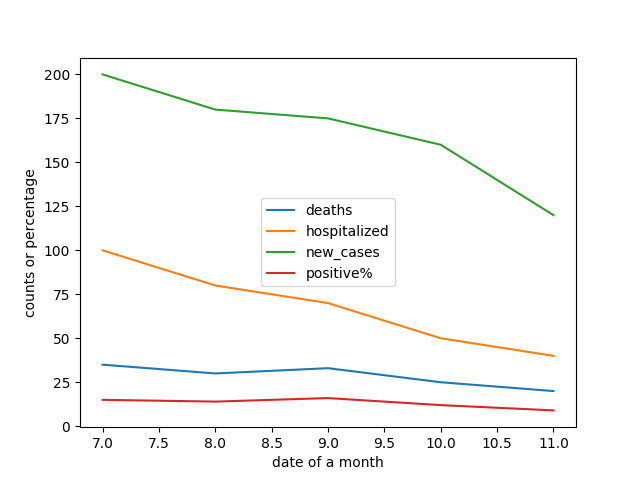
import pandas as pd
import matplotlib.pyplot as plt
data = {
'new_cases': [200, 180, 175, 160, 120],
'hospitalized': [100, 80, 70, 50, 40],
'deaths': [35, 30, 33, 25, 20],
'positive%': [15, 14, 16, 12, 9]
}
df = pd.DataFrame(data, index=[7,8,9,10,11])
myfig = df.plot.line()
myfig.set_xlabel("date of a month")
myfig.set_ylabel("counts or percentage")
plt.show()
- descriptions for demo 1
- This is a very common case to see how things changes with time.
- For y-axis, there are MANYfor monitor, like death count.
- For x-axis, there is only time, like day of a month.
- In method pd.DataFrame, the argument index is to define the time values.
- We can more easily to get a idea by visualize a figure.
- Only one statement to create a figure from a dataframe directly.
- In demo 1, the data is from a python dictionary object.
- Module panda is used to create a data frame object.
- The dataframe is used to draw a figure drom data.
- Module matplotlib.pylot is to render the figure on the device.
--- DEMO 2 ---
- data from Sqlite relation database
- in mac, use the ide, DB Browser Sqlite, to create a database.
- The database name is test315.
- The file name is test315.db.
- The file is in the same folder for my later python code.
- add a table, mytable, with 4 columns as demo 1.
- added 5 rows.
- create a python file as below.
- run it, get the result as demo 1, with extra labels for x, y axis.
data in the database
new_cases hospitalized deaths testpositive
200 100 35 15
....
15 14 16 9
python code
import sqlite3
conn = sqlite3.connect('test315.db') # database in folder peter
import pandas as pd
import matplotlib.pyplot as plt
df = pd.read_sql_query("select * FROM mytable", conn) # DataFrame
df2 = pd.DataFrame(df.values,
index=[7,8,9,10,11],
columns=['new cases', 'hospitalized', 'deaths', 'test positive %'])
myfig = df2.plot.line(title='COV-19 update, town xyz, March 2021')
myfig.set_xlabel("date of a month")
myfig.set_ylabel("counts")
plt.show()
conn.close()
- descriptions from demo 2
- The data in demo 2 is from a relation database, sqlite.
- Panda provides a method to retrieve data from the sqlite databases to a data frame for draw.
- It is a common way to get data.
- There are similar way for other relation or NoSql databases.
- One method's argument is a sql statement.
- A sql statement can also be used to process the data in database tier.
Another way for io.
mycursor = mydb.cursor() # Cursor is an object to store rows temporary in memory.
mycursor.execute("SELECT * FROM customers")
myresult = mycursor.fetchall()
If the above code is used to IO, a list of tuples will be returned.
--- DEMO 3, Scatter Plot ---
- w3c tutorial, Pandas, Plot, scatter example is used.
- data
- csv file
- Two columns are involved - exercise duration, calories consumption.
- Plot points with duration as x-axis, calorire as y-axis for all rows.
import pandas as pd
import matplotlib.pyplot as plt
df = pd.read_csv('data.csv') #comment: It can be from a database.
df.plot(kind = 'scatter', x = 'Duration', y = 'Calories')
plt.show()
- The plot helps you to see the correlation between the two.
- In this case, there is a relationship between the two columns.
- It is linear.
- The calories consumes more as the duration increases.
--- DEMO 4, Line Plot ---
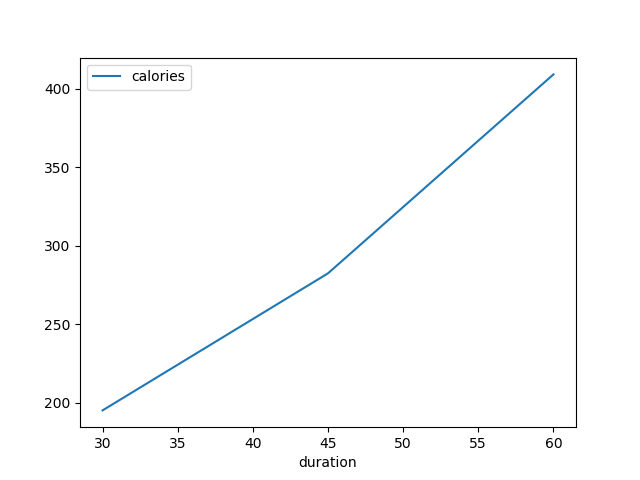
- continue from demo 3, the same data
- Replacing the line for plot as below:
df.plot.line(x = "Durations", y ="Calories"). - The default kind for df.plot is line plot.
- The method will plot lines between two points from any adjacent two data rows automatically.
- The focus is the relationship between them.
--- DEMO 5, histogram ---
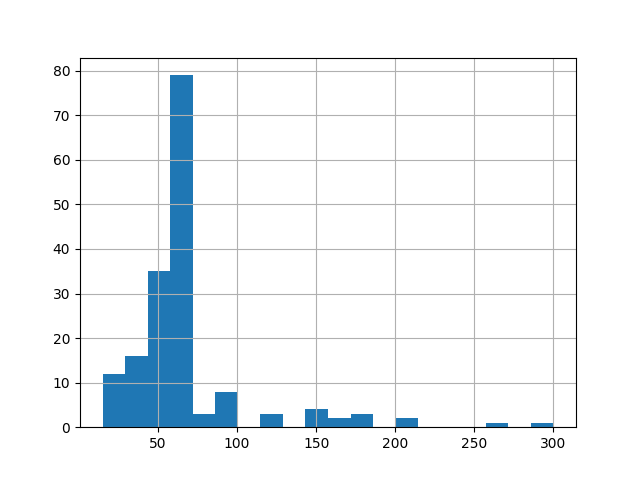
import pandas as pd
import matplotlib.pyplot as plt
df = pd.read_csv('data.csv')
df["Duration"].hist(bins=20)
plt.show()
- When people exercise, they record the duration of exercises.
- In this demo, the data is in a csv file.
- The duration ranges are in x-axis.
- The counts for any duration range are in y-axis
- From the plot, you can tell the counts for all ranges.
- In this demo, the person ususaly spends 60-70 minutes for exercise.
--- DEMO 6, bar plot ---
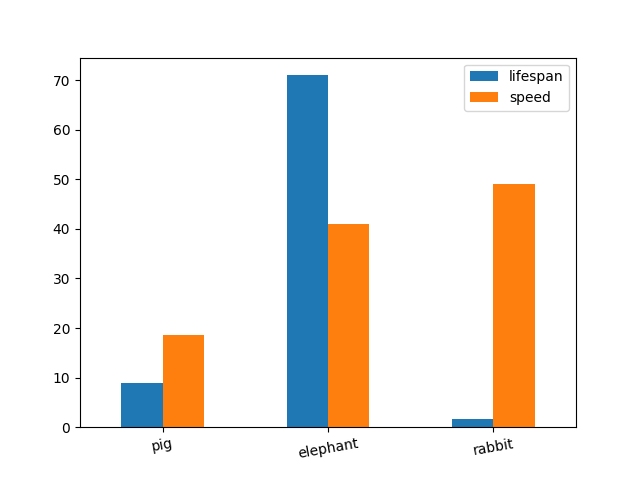
import pandas as pd
import matplotlib.pyplot as plt
speed = [18.5, 41, 49] #avg values
lifespan = [9, 71, 1.6] #avg values
index = ['pig', 'elephant','rabbit']
df = pd.DataFrame({'speed': speed, 'lifespan': lifespan},
index=index)
df.plot.bar(rot=10)
plt.show()
comment: What you give, what you see.
--- DEMO 7, pie plot ---

import pandas as pd
import matplotlib.pyplot as plt
df = pd.DataFrame(
{
'town A': [ 35001, 12000], #for one subplot
'town B': [ 29010, 55003], #for one subplot
'town C': [ 32597, 41055] #for one subplot
},
index = ['YES', 'NO'] # pie items
)
df.plot.pie(subplots=True,
figsize=(10,2),
title = "Vote Count Pie Plot for three towns")
plt.show()
--- DEMO 8, DataFrame, Mongodb, Plotting ---
------------ Prepare data in Mongodb ---------------
import pymongo
myclient = pymongo.MongoClient("mongodb://localhost:27017/")
mydb = myclient["mydatabase"]
mycol = mydb["mycollection"] #collection, like table in sql
# drop the collection if it exists
mycol.drop()
r = {"duration": 60, "calories": 409.1} #dictionary
d = mycol.insert_one(r) #document, like row in sql
r = {"duration": 45, "calories": 282.4}
d = mycol.insert_one(r)
r = {"duration": 30, "calories": 195.1}
d = mycol.insert_one(r)
# test code
for doc in mycol.find():
print(doc)
# See 3 dictionaries, each has three key-value pairs.
- descriptions
- Make sure the environment is setup properly - mongodb, and the driver
- Two command windows are needed - running mongod and running your code.
- Line 1 is the driver.
- Line 2 is the mongodb client info.
- Line 3 is the database name.
- Line 4 is the collection name, like tabel in SQL db.
- Then, prepare a dictionary, and insert it into the collection. Repeat 3 times.
- Verify the result.
------- Using DataFrame to import NoSql db and plotting------
import pymongo
myclient = pymongo.MongoClient("mongodb://localhost:27017/")
mydb = myclient["mydatabase"]
mycol = mydb["mycollection"]
import pandas as pd
df = pd.DataFrame(list(mycol.find())) # for many documents
# verify
print(df)
import matplotlib.pyplot as plt
df.plot.line(x = "duration", y = "calories")
plt.show()
verification result
_id calories duration
0 .... 409.1 60
1 .... 282.4 45
2 .... 195.1 30
plotting
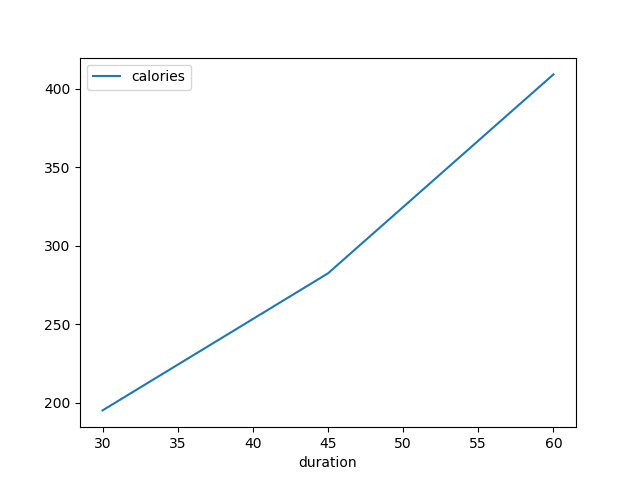
04.07 Pandas Documents...
- DataFrame is the main section in Pandas documents.
- In it, there are many methods like groupby, sort, pivot, etc.
- Examples are provided, you can use them for the needs.
- You can get data from a csr file or databases, then analyze, plot,update it.

